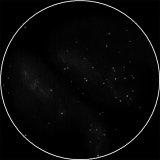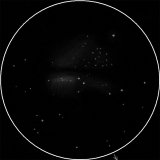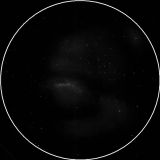
| MESSIER 8 |
|---|
RA: |
18h 03m 42s |
|
DEC: |
-24° 23' 00'' |
|
Type: |
Emission nebula |
|
NGC: |
6523 |
|
Magnitude: |
5.0 |
|
Surface brightness : |
12.8 |
|
Apparent dimensions : |
45'x30' |
|
Distance: |
5,200 ly |
|
The Lagoon Nebula (also known as Messier Object 8 (M8) and NGC 6523) is a giant interstellar cloud and H II region, in the constellation Sagittarius. At an estimated distance of 4,100 light-years, the Lagoon is one of only two star-forming nebulae faintly visible to the naked eye from mid-northern latitudes. In binoculars, the Lagoon is a distinct oval cloudlike patch with a definite core, like a pale celestial flower. The nebula has a delicate star cluster superimposed on it, making this one of the leading celestial sights of summer night skies. The Lagoon Nebula spans 90' by 40' on the sky which, at its calculated distance of 4,100 light years, translates to an actual dimension of 110 by 50 light years. The nebula contains a number of globules, dark, collapsing clouds of protostellar material, the most prominent of which have been catalogued by E. E. Barnard as numbers B88, B89 and B296. It also contains the so-called "Hourglass Nebula" (so named by John Herschel) in its central area, though this particular nebula is not related to the more commonly referenced Hourglass Nebula which lies in the southern constellation of Musca. It was discovered by Guillaume Le Gentil in 1747. Like many nebulae, the Lagoon appears pink in time-exposure color photos but is gray to the eye peering through binoculars or a telescope, human vision having poor color sensitivity at low light levels.
|
||
Other sketches |
|||||
 |
 |
||||
Messier 8 (July 06). |
Messier 8 (June 06) | ||||
VEDRAN VRHOVAC© 2006.-2007. |
